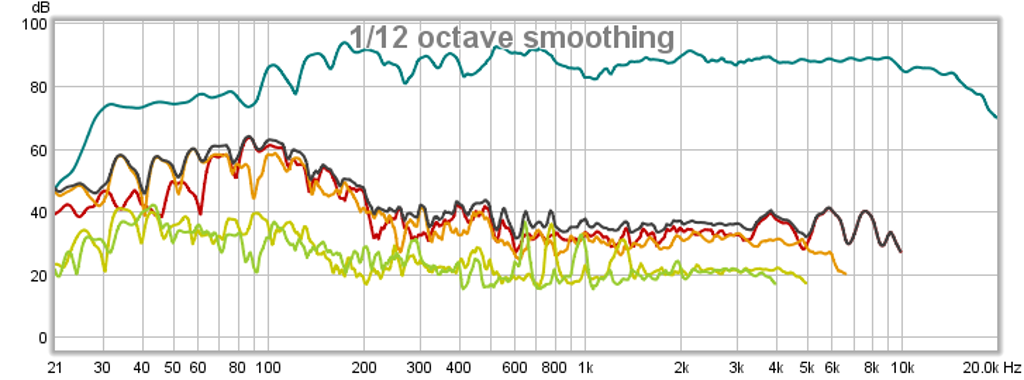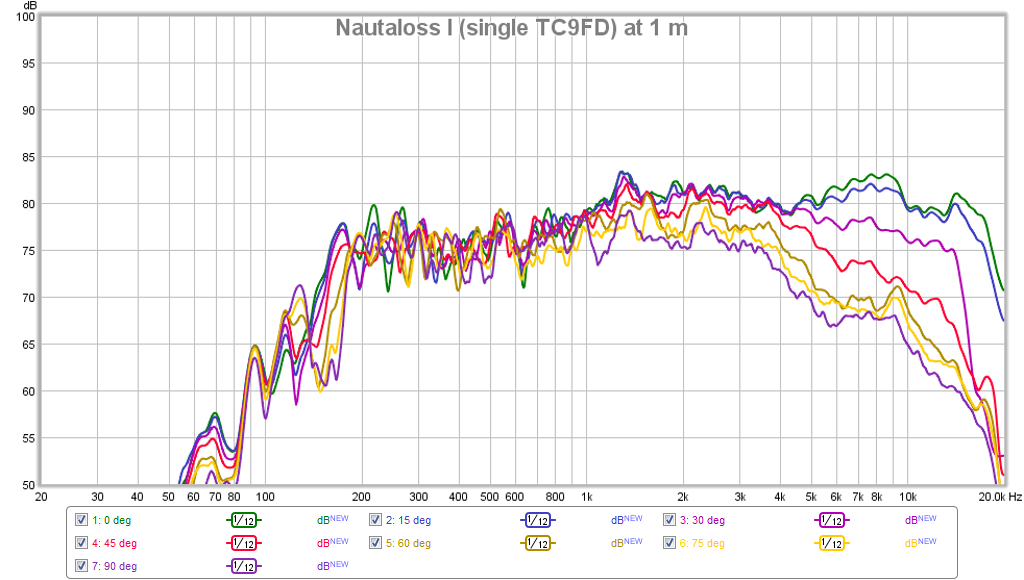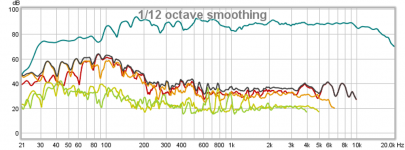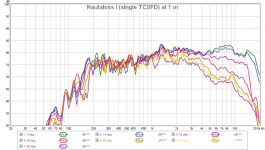Indeed they are cheap -AFAIK, best performing widebanders at / near the price range.
Yup, although I'd still go a bit careful. As an ROT, I will not tune < 0.707 Fs. They'll rarely thank you for it. Arrays (as in starting at, oh, call it 9 to pull a number out of the air) are somewhat different of course since you've got a substantial number of units to share the load. Ditto large (full sized) bass horns, for different reasons. And agreed, multiples do give additional flexibility in terms of dispersion etc. if needed / desired & the hardware is available where applicable. Name your poison. The more options available the better IMO.
Yup, although I'd still go a bit careful. As an ROT, I will not tune < 0.707 Fs. They'll rarely thank you for it. Arrays (as in starting at, oh, call it 9 to pull a number out of the air) are somewhat different of course since you've got a substantial number of units to share the load. Ditto large (full sized) bass horns, for different reasons. And agreed, multiples do give additional flexibility in terms of dispersion etc. if needed / desired & the hardware is available where applicable. Name your poison. The more options available the better IMO.
Scottnmoose,
I take no offense in you pointing out that measurements without an anechoic chamber may not be accurate beyond 30 deg, but these are measurements taken in a typical diy user's home listening environment and should be taken just as that. If I have time and the when the weather improves, I may repeat them outside for a pseudo anechoic chamber. I am frankly surprised (pleasantly so) that the response is this good. If the measurements outdoors pan out - I would almost say that these drivers are hard to beat at almost any price.
Regarding distortion at low frequencies - yes it starts to climb from -50 dB when you go lower than 200 Hz. I have accidentally achieved audible bass levels (75 dB) down to 30 Hz! Perhaps room gain going on but nonetheless - measurable. This was in a wall mounted flat "Accidental MLTL" which actually sounds quite nice as a background music speaker. I am still scratching my head over this one - the HD was large but no greater than -10dB at the worst, and typically better than -12 to -15dB below 200 Hz.
Here is the HD measurement at 1 m away with speaker mounted 53 in above floor (driver axis):

More details on the speaker here: http://www.diyaudio.com/forums/full-range/223313-foam-core-board-speaker-enclosures-147.html#post3400954
I take no offense in you pointing out that measurements without an anechoic chamber may not be accurate beyond 30 deg, but these are measurements taken in a typical diy user's home listening environment and should be taken just as that. If I have time and the when the weather improves, I may repeat them outside for a pseudo anechoic chamber. I am frankly surprised (pleasantly so) that the response is this good. If the measurements outdoors pan out - I would almost say that these drivers are hard to beat at almost any price.
Regarding distortion at low frequencies - yes it starts to climb from -50 dB when you go lower than 200 Hz. I have accidentally achieved audible bass levels (75 dB) down to 30 Hz! Perhaps room gain going on but nonetheless - measurable. This was in a wall mounted flat "Accidental MLTL" which actually sounds quite nice as a background music speaker. I am still scratching my head over this one - the HD was large but no greater than -10dB at the worst, and typically better than -12 to -15dB below 200 Hz.
Here is the HD measurement at 1 m away with speaker mounted 53 in above floor (driver axis):

More details on the speaker here: http://www.diyaudio.com/forums/full-range/223313-foam-core-board-speaker-enclosures-147.html#post3400954
Attachments
Last edited:
You can't beat physics but the TC9FD apparently is using physics to its full extent because that huge dip at 7kHz is not there.
The TC9 curves from Peerless (Tymphany) and Madisound are somewhat different:
http://www.tymphany.com/files/TC9FD18-08 Spec sheet Rve3_0 100912.pdf
The Madisound Speaker Store
and show a response much like the TG9. It will be interesting to explore the causes of the divergence. Soft cones will exhibit some degree of progressive decoupling (the cone acts as an ever shrinking surround as frequency rises, reducing the size of the radiating surface and thus reducing beaming) but the manufacturer's data don't indicate much of that with the TC9. Something else must be happening to produce the curves you are getting . . . it will be interesting to see what that is . . .
X,
Considering this is a very good performing tweeter, it would appear to be the perfect driver. Where is Markus?
https://plus.google.com/photos/1016...5843543468557791058&oid=101632266659473725850
Considering this is a very good performing tweeter, it would appear to be the perfect driver. Where is Markus?
https://plus.google.com/photos/1016...5843543468557791058&oid=101632266659473725850
But they are dirt cheap. You could buy 2 or more for the same price as the "low end" MA drivers (CHX-70 and the small Alpair).
Angled arrays or line arrays (Roger Russell) would give you any kind of dispersion you'd want and better low end (two drivers should be able to hit 50 without straining too much and four would touch the mid 40s).
I don't think there is anything really inconsistent between my measurements and the factory measurements. It may be due to the presentation scale that I used. The -10dB to +110dB scale as used by MA has a nice way showing a driver in the best light. Here is the same data presented on the 50dB to 100dB scale used by Tymphany. Now with warts exposed, you can see that the 60 deg data is about the same in both measurements.

Attachments
Scottnmoose,
I take no offense in you pointing out that measurements without an anechoic chamber may not be accurate beyond 30 deg, but these are measurements taken in a typical diy user's home listening environment and should be taken just as that. If I have time and the when the weather improves, I may repeat them outside for a pseudo anechoic chamber. I am frankly surprised (pleasantly so) that the response is this good. If the measurements outdoors pan out - I would almost say that these drivers are hard to beat at almost any price.
Regarding distortion at low frequencies - yes it starts to climb from -50 dB when you go lower than 200 Hz. I have accidentally achieved audible bass levels (75 dB) down to 30 Hz! Perhaps room gain going on but nonetheless - measurable. This was in a wall mounted flat "Accidental MLTL" which actually sounds quite nice as a background music speaker. I am still scratching my head over this one - the HD was large but no greater than -10dB at the worst, and typically better than -12 to -15dB below 200 Hz.
Here is the HD measurement at 1 m away with speaker mounted 53 in above floor (driver axis):

More details on the speaker here: http://www.diyaudio.com/forums/full...board-speaker-enclosures-147.html#post3400954
X have you measured distortion with a naked driver nearfield? If you have would love to see results.
Am wondering if the enclosure itself is not causing part of the distortion issue despite being a small drivers asked todo a much larger ones job. Flexible enclosures do have more of a tendency to induce. The sonotube (sakrete) tubes I often use are a bit stronger than foam core enclosures with more dampening added. Am thinking about using a pressure zone type mic setup to measure enclosure resonances/ transparency as I'm interested in dampened constrained layer construction.
Room-gain certainly wouldn't be hurting re the LF output mentioned.  I've had similar things happen.
I've had similar things happen.
Right, the scale certainly can alter the appearance at first glance so (speaking generally) this is something that should always be factored in when looking at driver data.
Pass re the details of the HD levels; could be any one of a number of factors, so we'd need to be taking it back to the raw anechoic measures on an IEC standard test baffle, preferably in an anechoic chamber to have a baseline. Interesting though. As indicated it's higher than I like, but that's somewhat of a moot point since this is where personal preferences / criteria etc. all start to kick in & no doubt still very useful in nearfield etc., since we're not really talking 'ideal world' situations. Or we'd all be running our dream systems.
Right, the scale certainly can alter the appearance at first glance so (speaking generally) this is something that should always be factored in when looking at driver data.
Pass re the details of the HD levels; could be any one of a number of factors, so we'd need to be taking it back to the raw anechoic measures on an IEC standard test baffle, preferably in an anechoic chamber to have a baseline. Interesting though. As indicated it's higher than I like, but that's somewhat of a moot point since this is where personal preferences / criteria etc. all start to kick in & no doubt still very useful in nearfield etc., since we're not really talking 'ideal world' situations. Or we'd all be running our dream systems.
But you ask any manufacturer or pro-testing body whether they think high off-axis measures are likely to be particularly accurate without full industry standard test gear in an anechoic chamber. With very few exceptions, you'll get the same (polite) answer -viz. 'no'.
Pretty obvious why they answer that way
Anyway gated measurements will result in "good" data. Of course there's always a trade-off between gate length and frequency resolution. This is a huge problem at low frequencies but not at higher frequencies.
Here is the same data presented on the 50dB to 100dB scale used by Tymphany.
Thanks for posting these! Could you upload the .mdat?
Yes. They answer that way because it's inherently true. A proper measurement environment and equipment is / are superior to anything most of us have access to. Alas. There's a reason they exist. I'd dearly love to be able to think that the equipment I have is of equal capability. But it isn't. It's OK, but it's not perfect and I am aware of the limitations.
Yes. They answer that way because it's inherently true. A proper measurement environment and equipment is / are superior to anything most of us have access to. Alas. There's a reason they exist.
Oh, I thought they were here to make money...
My bad - I know but couldn't resist... Sorry...
Regards
Indeed. They would make a very good low cost 2-way (FASTish) crossed conservatively at around 300Hz. Even the venerable (and otherwise horrible above 300) Dayton DC160 Zaph|Audio would serve well for such a "budget" low end, since the TC9 not only reaches three octaves lower than the dome in the cone-and-dome kit PE used to sell, but it performs better on the high end as well.I rather like them since while there are some things you might wish they did more of, they don't do anything annoying. Which is a bigger deal than it sounds / reads, if you know what I mean.
Thanks for posting these! Could you upload the .mdat?
The files are huge and beyond size limit for uploads. Unless there is a way to save it compactly? I suspect the .wav audio file is embedded in the .mdat file. PM me and I can email it to you if still interested.
Of course they make money. Not a crime, last I checked. But that doesn't alter the fact that they have far better facilities than most of us have access to. Nobody denies much of the gear available to us is very capable, but it's not up to those levels and you're kidding yourself if you think it is. I regretfully gave up on that happy illusion some time ago, much as I wish it were true.
- Status
- Not open for further replies.
- Home
- Loudspeakers
- Full Range
- 3"or 4" driver with very good dispersion and high xmax?

